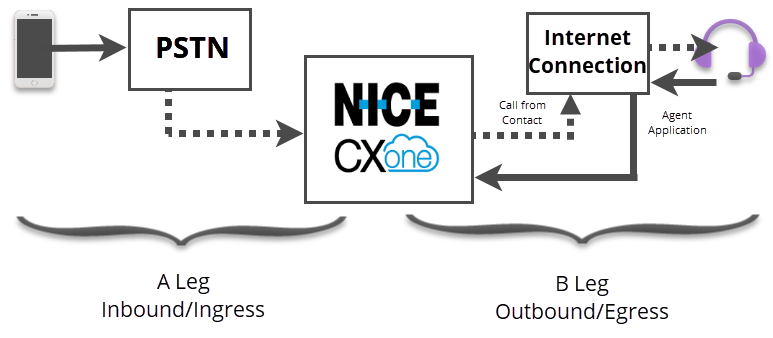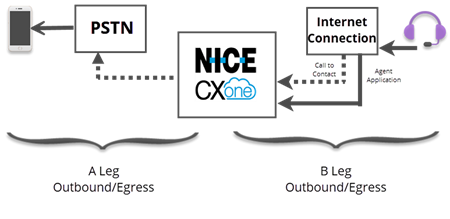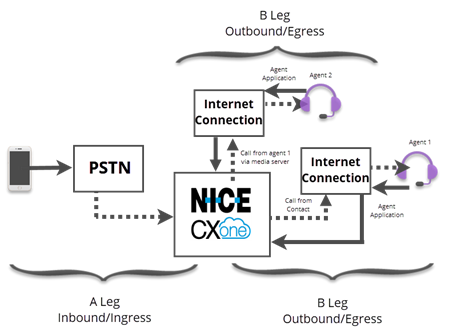When a contact![]() The person interacting with an agent, IVR, or bot in your contact center. wants to talk to your organization, they make a phone call, send email, or start a chat on your company website.
The person interacting with an agent, IVR, or bot in your contact center. wants to talk to your organization, they make a phone call, send email, or start a chat on your company website. ![]() The entry point that an inbound contact uses to initiate an interaction, such as a phone number or email address. in CXone Mpower, CXone Mpower takes over handling of the interaction. It routes the interaction to the available agents who can help the contact.
The entry point that an inbound contact uses to initiate an interaction, such as a phone number or email address. in CXone Mpower, CXone Mpower takes over handling of the interaction. It routes the interaction to the available agents who can help the contact.
Connectivity is the ability to connect multiple systems and applications so they can work together. This is what allows your organization's contacts and agents to communicate. CXone Mpower can connect to many systems, allowing your organization to connect with contacts in lots of different ways, including phone, email, SMS![]() Short Message Service; also known as text messaging., chat
Short Message Service; also known as text messaging., chat
Each of these methods of communication require different mechanisms, protocols, and configurations. For example, SMS uses a different protocol, or set of rules, than phone calls do. The key to understanding connectivity in CXone Mpower is understanding the mechanisms and protocols required by the communication methods your organization uses.
Voice is a complex communication method, because there are many technologies that can be used to transmit a call between the caller and the destination. Much of the information about connectivity in this section of the online help relates to voice. However, CXone Mpower connectivity touches all methods of communication, also known as channels.
The challenge your organization faces is ensuring that the required protocols and mechanisms are properly set up and configured to work with your specific requirements. Every organization's requirements are unique, so there is not a one-size-fits-all approach to connectivity when starting out with CXone Mpower. Work with your Account Representative to ensure that you're using the technologies and protocols required to meet your organization's needs.
Connectivity in the Cloud
CXone Mpower is a cloud-based platform, which means that your organization doesn't have any computers on site with CXone Mpower installed on them. Instead, CXone Mpower users connect to the computer systems where CXone Mpower is installed using a web browser and an internet connection.
The computers that run CXone Mpower are located in data centers that are owned and operated by other organizations. NiCE uses Amazon Web Services (AWS). AWS owns and manages the data centers, computers, and other hardware. NiCE manages the software installed on the computers.
To provide scalability and redundancy, there are multiple computer systems, called servers, that work together. This is known as a cluster. CXone Mpower assigns each cluster a name that's made up of a letter and a number. For example, C14, E39, or M33. Your organization's instance of CXone Mpower runs on a specific cluster. When working with CXone Mpower connectivity, you need to know which cluster your CXone Mpower system runs on.
Components of CXone Mpower Connectivity
Connectivity with CXone Mpower involves several main components. They're described in the following table.
| Component | Details |
|---|---|
| Network | Your organization's network must be secure and reliable. This is the fundamental part of any cloud connectivity setup. The network can be a local area network (LAN) or a wide area network (WAN). |
|
Carrier |
Your network must be connected to the internet with a reliable, high-speed, secure connection. The company that provides your internet connection is called a carrier. |
| Voice Point of Presence | A voice Point of Presence (PoP) is the physical location where your carrier connects to the public switched telephone network (PSTN). The PoP acts as a gateway for voice calls to and from the carrier's network. It allows the carrier to provide voice-related services to their customers. |
| SIP Trunk | A Session Initiation Protocol (SIP) trunk is a virtual connection that allows your PBX system to communicate with your carrier's network. It can use a traditional phone line, VoIP, or a dedicated connection like MPLS. |
| CXone Mpower |
CXone Mpower is the software platform that manages interactions from the moment the call or message enters the system until they're complete. It provides the tools agents use to handle interactions |
After an interaction has entered the CXone Mpower system, additional components are required to complete the connection between the contact![]() The person interacting with an agent, IVR, or bot in your contact center. and your organization:
The person interacting with an agent, IVR, or bot in your contact center. and your organization:
-
IVR: An Interactive Voice Response (IVR) system is a software application that allows callers to interact with the phone system using voice commands or the buttons on their phone. IVRs are often used to provide automated call answering and routing services. These services could allow callers to choose what department to speak with or to leave a voicemail message. Your organization can create IVRs in CXone Mpower.
For interactions that happen on other channels
 Various voice and digital communication mediums that facilitate customer interactions in a contact center., such as email or chat, an IVR isn't used. The contact may be given a choice of who to communicate with in other ways. For example:
Various voice and digital communication mediums that facilitate customer interactions in a contact center., such as email or chat, an IVR isn't used. The contact may be given a choice of who to communicate with in other ways. For example: - Your company website may have a list of email addresses to let contacts choose whether to email support or customer service.
- The chat window on your website might have a pre-chat survey built into it that asks contacts which team they want to chat with.
- Interaction Routing Flow: This is the path an interaction takes from the moment it enters the system until it's complete. The routing flow must determine which agents can handle the interaction, place the interaction in a queue, and handle other actions, such as transfers. It can also include steps such as playing prompts or messages for the contact or dialing a phone number.
- Agent: The agent is the person who communicates with the contacts. CXone Mpower agent applications allow agents to communicate with contacts using any supported method all within one application. They can use physical phones, softphones, email, chat windows, and more. Additionally, interactions can be inbound, started by the contact, or outbound, started by the agent.
Basics of Call Flow in CXone Mpower
This section introduces some important terminology and describes the basic flow of how contacts and agents are connected via CXone Mpower. The example interactions used in this section happen on a voice channel![]() Various voice and digital communication mediums that facilitate customer interactions in a contact center..
Various voice and digital communication mediums that facilitate customer interactions in a contact center..
If you want to learn more about how CXone Mpower routes calls, the Scripts and CXone Mpower section on the Fundamentals page in the Studio online help describes the process. Studio is the application used to create scripts to define routing flow in your contact center. You can also learn more about how information flows through the platform on the Network Diagrams help page.
Inbound Calls: A and B Legs
CXone Mpower sits between contacts and the agents who handle interactions with those contacts. Agents connect to CXone Mpower by logging in to an agent application, such as MAX
The contact places a phone call to one of your organization's local or toll free phone numbers. The call originates with the contact's local or wireless phone company and traverses the Public Switched Telephony Network (PSTN). When it reaches your organization, it enters the CXone Mpower system. CXone Mpower categorizes the call and places it in a queue to be answered by agents who have the necessary skills or qualifications.
In CXone Mpower, the portion of the call between the contact and CXone Mpower is known as the A leg. The portion of the call between CXone Mpower and the agent is known as the B leg or the agent leg. The two legs of the call are connected in CXone Mpower on a media server.
The A leg is coming in to CXone Mpower from an external point, so it's referred to as inbound or ingress traffic. The agent leg is classified as outbound or egress, because the call itself is coming from CXone Mpower and terminating at a point outside of CXone Mpower—the agent application.
Outbound Calls: A and B Legs
Agents connect to CXone Mpower when initiating outbound interactions in the same way they do for inbound interactions. They use the same agent application and connect to CXone Mpower over the internet.
Using the agent application, the agent dials the phone number of the contact they want to speak with. Alternatively, if configured to do so, CXone Mpower can dial the call automatically and show the agent information about who their next contact is. CXone Mpower places an outbound call to the destination number. The call traverses the PSTN and rings on the contact's phone. As with inbound calls, both legs are connected in CXone Mpower on a media server.
Both the A leg and the B leg are considered outbound or egress traffic. Both legs originate in the CXone Mpower platform and terminate outside of the platform.
Call Transfers: A Leg and Two B Legs
Call transfers introduce a second B or agent leg, as shown in the following diagram. The diagram shows the transfer of an inbound call, but it works the same way with an outbound call. In an outbound call, there would be three egress legs instead of one ingress leg and two egress legs.
In this scenario, two agents are connected to CXone Mpower over the internet using agent applications. When agent 1 transfers the call to agent 2, CXone Mpower places an outbound call to agent 2. This call is a second B leg. All three legs are connected in CXone Mpower on a media server. When the call between the contact and agent 2 is established, agent 1 drops from the call.
Phone Number Management
Your organization has one or more phone numbers that contacts can use when they want to reach your agents. There are several methods of being able to accept calls to those numbers in CXone Mpower. The preferred option is to authorize CXone Mpower as the Responsible Organization (RespOrg) for the toll free numbers you want to use with CXone Mpower. Local numbers can also be ported to CXone Mpower, if your organization wants to.
Other methods of having calls sent to CXone Mpower include:
- Remote Call Forwarding (RCF)
- Directly from an independent carrier
- Directly from your PBX
If your organization uses CXone Mpower as the RespOrg, you must go through CXone Mpower to order additional phone numbers. Otherwise, you must contact your organization's phone carrier to arrange for new numbers.
Phone Call Transport Methods
There are two ways a phone call can arrive at its destination after the caller dials the phone number. The methods are:
- Public Switched Telephone Network (PSTN): This is the traditional land-line phone system. CXone Mpower classifies any phone traffic that's routed via DID
 Direct Inward Dial (DID). Service that assigns a unique phone number to each employee without a phone line for each number. or Toll-Free Number (TFN) as PSTN.
Direct Inward Dial (DID). Service that assigns a unique phone number to each employee without a phone line for each number. or Toll-Free Number (TFN) as PSTN. - Voice over Internet Protocol (VoIP): This method transports phone calls over the internet. It requires the use of a VoIP-enabled phone or a softphone installed on agents' computers.
Both methods can be used on the agent (B) leg of interactions. CXone Mpower supports the use of PSTN on the A leg. It restricts the use of VoIP to the agent leg only. Some CXone Mpower UCaaS (Unified Communications as a Service) partners allow the use of VoIP on the A leg, so if this is an option your organization needs, talk to your Account Representative.
CXone Mpower provides the Call Quality Explorer report so your organization can monitor issues on your voice channels, such as latency, jitter, or dropped calls.
Softphone Options for Use with CXone Mpower
If your organization uses VoIP for the agent leg of interactions, CXone Mpower offers two softphone options:
- Integrated Softphone: An application that's built into the CXone Mpower platform, so there's nothing to install on agent computers.
- Softphone: A separate application that must be installed on agent computers.
Integrated Softphone is sometimes referred to as WebRTC. The two names don't refer to the same thing. WebRTC is the communications technology that's available in the Chrome web browser. It's what the CXone Mpower application called Integrated Softphone uses.
If you use Integrated Softphone in your contact center, there are IP addresses must be added to your allowlist.
Firewalls
In computer networks, a firewall is a hardware or software solution that creates a barrier between networks and monitors the traffic going in and out. Your organization has a firewall that monitors traffic between the internal network and external networks, such as the internet. There may be additional firewalls within your internal network to provide segmentation of the network or to provide extra protection for certain resources.
Firewalls watch network traffic and identify threats based on its defined security rules. They can be set up to protect against different kinds of threats. They can protect access to the network and the resources within the network. They can prevent malware and malicious attacks from affecting the network. They can also monitor network activity to identify security problems.
To ensure that CXone Mpower can function properly, there are a number of domain names, IP addresses, and ports that need to be allowed or opened in your firewall. The list of approved domain names and IP addresses is known as an allowlist.
Proxy Servers and CXone Mpower
Proxy servers are another form of network protection. They facilitate connections over a public or private network. A proxy server acts as a gateway between devices and the rest of the internet, accepting requests from the devices and returning data to the devices from each request. Proxy servers aren't the same as firewalls, and your organization may have both.
CXone Mpower does not support the use of traffic inspection proxy services for several reasons:
- Routing your WAN traffic through a proxy introduces packet latency. CXone Mpower solutions are real-time. Delays in packet delivery impair both agent and customer experience.
- Proxy service providers conduct regular maintenance. This can impact your system and even make it unavailable.
- Inadvertent changes to routing policies can create disruptions in service.
- When problems occur, assistance from the third-party proxy provider is necessary to ensure thorough troubleshooting. This helps avoid delays in resolution and extended disruptions to service.
If you decide to use a proxy service, you must configure it to work with CXone Mpower yourself.
Security in CXone Mpower Connectivity
NiCE takes the security of the connections between your organization's network and our network very seriously. To ensure that you have a secure, encrypted connection, CXone Mpower requires at least TLS 1.2 compliance and the following ciphers as noted.
Inbound Traffic (from CXone Mpower to your servers)
You must support at least one of the following ciphers on servers that CXone Mpower communicates with such as IVR scripts or other integrations. It is recommended that you support multiples of these ciphers if possible. If you are trying to integrate with other service providers, you are responsible for ensuring that those providers also meet these requirements.
- 0x009E, TLS_DHE_RSA_WITH_AES_128_GCM_SHA256
- 0xC013, TLS_ECDHE_RSA_WITH_AES_128_CBC_SHA
- 0xC02B, TLS_ECDHE_ECDSA_WITH_AES_128_GCM_SHA256
- 0xC02C, TLS_ECDHE_ECDSA_WITH_AES_256_GCM_SHA384
Outbound Traffic (from your servers to CXone Mpower)
You must support at least one of these ciphers from any source that communicates with CXone Mpower such as browsers and back-end integrations. It is recommended that you support both of these ciphers if possible.
- 0xC02F, TLS_ECDHE_RSA_WITH_AES_128_GCM_SHA256
- 0xC030, TLS_ECDHE_RSA_WITH_AES_256_GCM_SHA384




